Nicole schreibt...
Tuscany 2018 |
 |
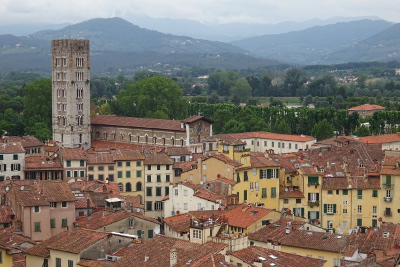 Thirteen years ago I visited Florence more out of a sense of duty than a genuine wish to see the city and its art. I knew virtually knowing about Renaissance art or the Medici and I was also still pretty much a scared chicken, when it came to being out and about on my own. As a result, while I did the usual sightseeing, I don't think I really got much out of Florence and didn't venture further into Tuscany at all. Something I regretted later. Now felt like a good time to make up for that and visit other cities in Tuscany I really wanted to see, most notably Siena. And since I had to change trains in Florence anyway, I decided to stay there overnight as well, retrace my steps with much bigger knowledge of the Renaissance and a better digital camera to boot.
So I was off, once again to Pisa Airport, the major airport into Tuscany, and immediately traveled on to Lucca, another place on my list. Not being too savvy on Tuscan geography I had not been aware that it's in the north, halfway between Pisa and Florence, so it was best to stay there for a night before moving on. Lucca's main fortune is that its massive city walls were never seriously damaged, enclosing the inner city until today, making it a lovely place with restricted traffic and full of gorgeous old buildings.
After dropping my suitcase at the Palazzo Alexander, my humble abode for the night (and indeed a proper palazzo with gorgeous interior decorations, except for my room which was rather bare and uninspired), I went for a walk to see the sights, such as the church San Michele in Foro with its unique facade. Built in 12th century, the church owes its name to the fact that it was planted on top of the old Roman forum:
Thirteen years ago I visited Florence more out of a sense of duty than a genuine wish to see the city and its art. I knew virtually knowing about Renaissance art or the Medici and I was also still pretty much a scared chicken, when it came to being out and about on my own. As a result, while I did the usual sightseeing, I don't think I really got much out of Florence and didn't venture further into Tuscany at all. Something I regretted later. Now felt like a good time to make up for that and visit other cities in Tuscany I really wanted to see, most notably Siena. And since I had to change trains in Florence anyway, I decided to stay there overnight as well, retrace my steps with much bigger knowledge of the Renaissance and a better digital camera to boot.
So I was off, once again to Pisa Airport, the major airport into Tuscany, and immediately traveled on to Lucca, another place on my list. Not being too savvy on Tuscan geography I had not been aware that it's in the north, halfway between Pisa and Florence, so it was best to stay there for a night before moving on. Lucca's main fortune is that its massive city walls were never seriously damaged, enclosing the inner city until today, making it a lovely place with restricted traffic and full of gorgeous old buildings.
After dropping my suitcase at the Palazzo Alexander, my humble abode for the night (and indeed a proper palazzo with gorgeous interior decorations, except for my room which was rather bare and uninspired), I went for a walk to see the sights, such as the church San Michele in Foro with its unique facade. Built in 12th century, the church owes its name to the fact that it was planted on top of the old Roman forum:
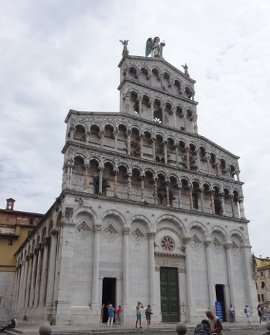 |
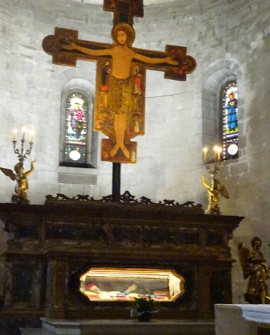 |
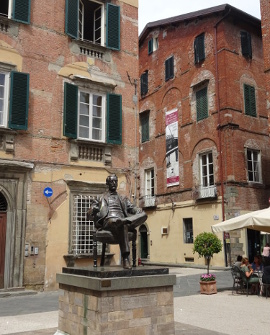 |
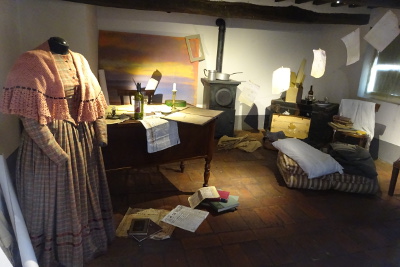 Almost next door is the birth house of Lucca's most famous son, opera composer Giacomo Puccini, which has been transformed into a museum. While I'm not an opera expert by any stretch of the imagination, I have a fondness for Puccini's operas and managed to see almost all of them by now. So it was lovely to learn a bit about the man himself and see costumes from his operas. On the left is the little garret on top of the kitchen, a hidey-hole for young Giacomo that supposedly inspired him to the setting of his famous opera "La Boheme" (incidentally also the first opera I ever saw live).
From here I moved on to Lucca's other famous church, the Cathedral of San Martino. Its proper front facade by the belltower was covered by tarpaulin, so here's a view from the other side. Next stop, after a cappuccino break, was the 45 metre tall Torre Guinigi, where I climbed 230 steps to reach the top and enjoy the view across town towards the hills of Tuscany. Oddly enough some trees have been planted at the top of the tower, offering shade and turning it into something quite unique:
Almost next door is the birth house of Lucca's most famous son, opera composer Giacomo Puccini, which has been transformed into a museum. While I'm not an opera expert by any stretch of the imagination, I have a fondness for Puccini's operas and managed to see almost all of them by now. So it was lovely to learn a bit about the man himself and see costumes from his operas. On the left is the little garret on top of the kitchen, a hidey-hole for young Giacomo that supposedly inspired him to the setting of his famous opera "La Boheme" (incidentally also the first opera I ever saw live).
From here I moved on to Lucca's other famous church, the Cathedral of San Martino. Its proper front facade by the belltower was covered by tarpaulin, so here's a view from the other side. Next stop, after a cappuccino break, was the 45 metre tall Torre Guinigi, where I climbed 230 steps to reach the top and enjoy the view across town towards the hills of Tuscany. Oddly enough some trees have been planted at the top of the tower, offering shade and turning it into something quite unique:
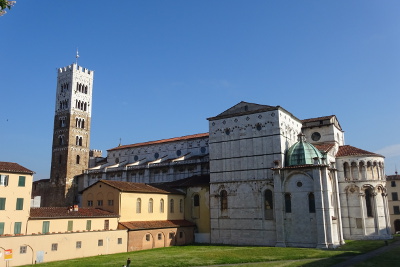
|
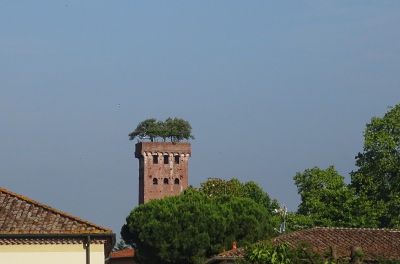 |
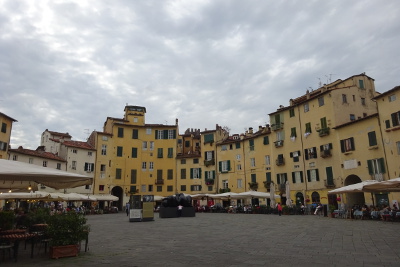 Finally I reached my last stop and the place that had been the major reason for wanting to see Lucca: The oval Piazza dell'Amfiteatro, built on the site of an ancient Roman theatre, so most of the houses are rather bendy (you can also see it on the very first photo above, which I took from the Torre Guinigi). As I had hoped, the lovely piazza was full of restaurants, so it was the perfect end to the walk before returning to my hotel.
I wasn't in a rush to leave Lucca next morning, so I did the popular walk along the ancient city walls all around the old town (about 4.2 kilometres) to enjoy some more good views on this charming little city. Then it was time to move on to Tourist Mayhem Central: Florence.
Finally I reached my last stop and the place that had been the major reason for wanting to see Lucca: The oval Piazza dell'Amfiteatro, built on the site of an ancient Roman theatre, so most of the houses are rather bendy (you can also see it on the very first photo above, which I took from the Torre Guinigi). As I had hoped, the lovely piazza was full of restaurants, so it was the perfect end to the walk before returning to my hotel.
I wasn't in a rush to leave Lucca next morning, so I did the popular walk along the ancient city walls all around the old town (about 4.2 kilometres) to enjoy some more good views on this charming little city. Then it was time to move on to Tourist Mayhem Central: Florence. 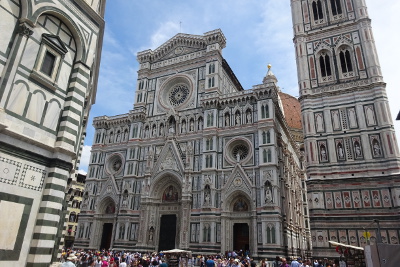 I had opted for a hotel just around the corner of Santa Maria Novella Station and once again could check-in early (the Italians, unlike the Brits, are really good at this!), so I took a short break before heading into the city proper. What can I say, just arriving in front of Florence's spectacularly beautiful Duomo with its unique white-green-pink colouring was enough to convince me that this stop-over had been a good idea.
While it was much busier than quaint Lucca of course, it wasn't quite as bad as I had feared (poor Venice is suffering more), although the long queue in front of the entrance of the Duomo quickly convinced me that there was no need to see the inside again. Instead I moved on to the Piazza della Signoria, Florence's living room in front of the Palazzo Vecchio, seat of the local rulers since before the Medici and until today. It was here Savonarola held his infamous Bonfire of the Vanities before being turned into a bonfire himself and many other events took place.
I had opted for a hotel just around the corner of Santa Maria Novella Station and once again could check-in early (the Italians, unlike the Brits, are really good at this!), so I took a short break before heading into the city proper. What can I say, just arriving in front of Florence's spectacularly beautiful Duomo with its unique white-green-pink colouring was enough to convince me that this stop-over had been a good idea.
While it was much busier than quaint Lucca of course, it wasn't quite as bad as I had feared (poor Venice is suffering more), although the long queue in front of the entrance of the Duomo quickly convinced me that there was no need to see the inside again. Instead I moved on to the Piazza della Signoria, Florence's living room in front of the Palazzo Vecchio, seat of the local rulers since before the Medici and until today. It was here Savonarola held his infamous Bonfire of the Vanities before being turned into a bonfire himself and many other events took place.
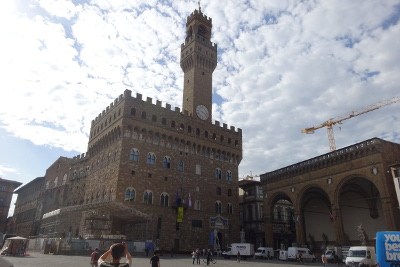
|
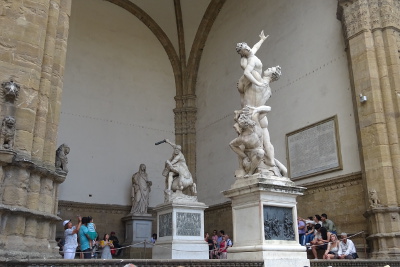 |
 |
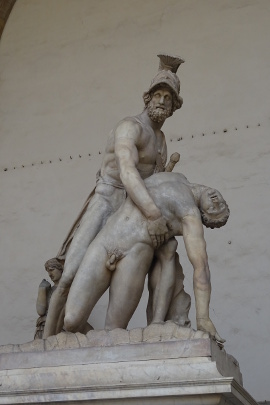 |
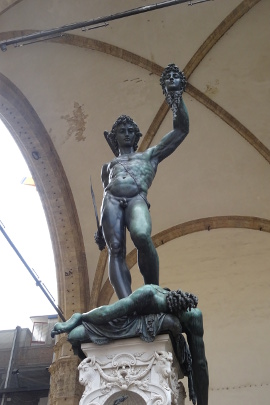 |
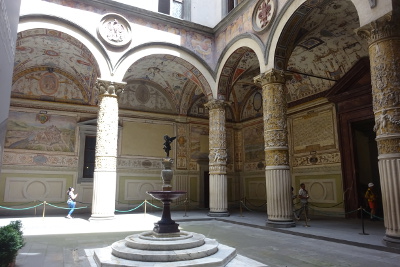
|
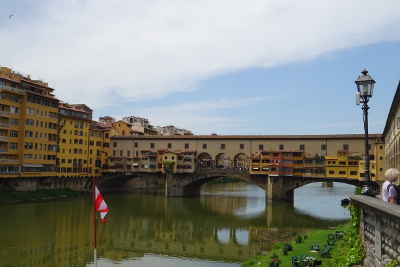 |
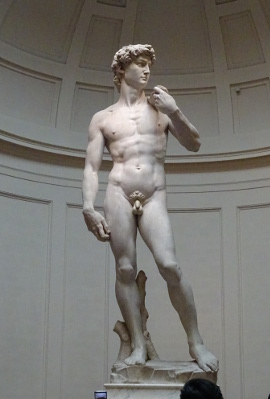 |
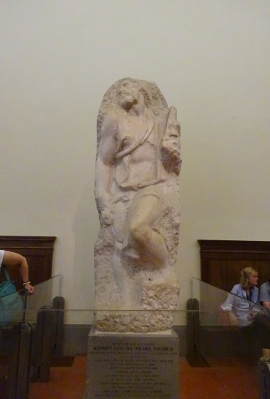 |
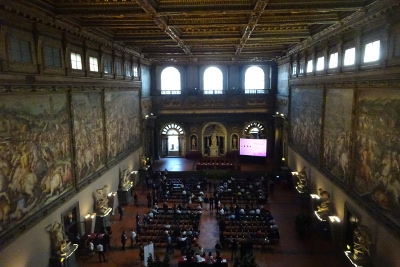 Next morning I headed into Florence one more time to finally get into the Palazzo Vecchio proper. The building dates from early 14th century and went through many names. It got its present one (Old Palace) when Cosimo de Medici upped sticks in 1540 and moved into the much bigger Palazzo Pitti on the other side of the Arno, but remains Florence's town hall to the present day. And there was actually something going down in the huge Salone del Cinquecento, which would be closed for tourists later the day, so I was pretty lucky, I rocked up early. This is the place where arch rivals Michelangelo and Leonardo Da Vinci had been asked to provide new huge battle frescoes that never happened, so the ones in place now are by Georgio Vasari, showing Florence finally getting one over their arch enemy Siena instead.
Next morning I headed into Florence one more time to finally get into the Palazzo Vecchio proper. The building dates from early 14th century and went through many names. It got its present one (Old Palace) when Cosimo de Medici upped sticks in 1540 and moved into the much bigger Palazzo Pitti on the other side of the Arno, but remains Florence's town hall to the present day. And there was actually something going down in the huge Salone del Cinquecento, which would be closed for tourists later the day, so I was pretty lucky, I rocked up early. This is the place where arch rivals Michelangelo and Leonardo Da Vinci had been asked to provide new huge battle frescoes that never happened, so the ones in place now are by Georgio Vasari, showing Florence finally getting one over their arch enemy Siena instead.
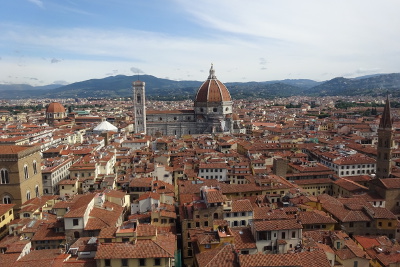
|
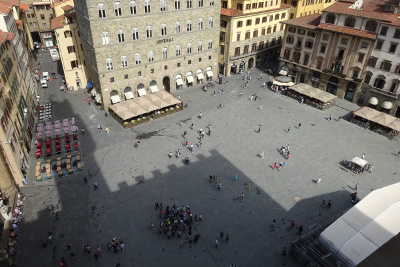 |
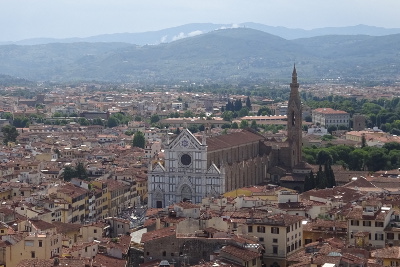 There are plenty more beautifully decorated rooms and finally a slog up 416 steps to the top of the 95 metre tall Torre Arnolfo to enjoy a prime view across Florence and down into the Piazza della Signoria. The church on the left is the Basilica di Santa Croce, which I didn't get around to visiting but which is famous for holding the tombs of many famous Italians including Michelangelo, Machiavelli and Galilei.
Well, at least it gives me an excuse to return to Florence another time some day, because I have definitely found a fresh appreciation for this city and its incredible riches of art. I might actually have liked to stay another day, but I had to move on to my final destination: Siena, a 90-minute train ride further south in the cliche rolling hills of Tuscany.
There are plenty more beautifully decorated rooms and finally a slog up 416 steps to the top of the 95 metre tall Torre Arnolfo to enjoy a prime view across Florence and down into the Piazza della Signoria. The church on the left is the Basilica di Santa Croce, which I didn't get around to visiting but which is famous for holding the tombs of many famous Italians including Michelangelo, Machiavelli and Galilei.
Well, at least it gives me an excuse to return to Florence another time some day, because I have definitely found a fresh appreciation for this city and its incredible riches of art. I might actually have liked to stay another day, but I had to move on to my final destination: Siena, a 90-minute train ride further south in the cliche rolling hills of Tuscany.
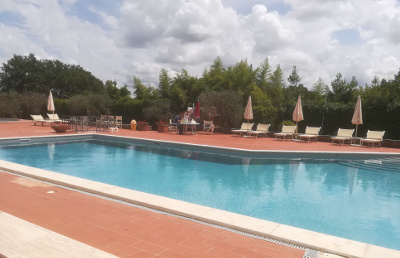 I had consciously chosen a hotel on the outskirts of the city that offered a large pool in order to mix sightseeing with hours of relaxation under the Italian sun at last. It also meant quite a slog from the train station first (especially since I promptly got lost), but the Hotel Garden turned out to be a great choice, an old Tuscan villa amid a big garden. After checking in (once more early) I first hopped into the wonderful pool and spent a while chilling before going off on my first walk into Siena proper - which took about half an hour to the famous Campo. Sadly, the Italian Gods of Weather decided to send an almighty thunderstorm across Siena just when I was leaving the cathedral and I hid in a cafe with cappuccino from the downpour. The weather didn't get better anymore with grey skies and drizzle, so I headed back to the hotel early and in order to avoid confusion I'll keep all the photos from Siena together for the last chapter here.
I had consciously chosen a hotel on the outskirts of the city that offered a large pool in order to mix sightseeing with hours of relaxation under the Italian sun at last. It also meant quite a slog from the train station first (especially since I promptly got lost), but the Hotel Garden turned out to be a great choice, an old Tuscan villa amid a big garden. After checking in (once more early) I first hopped into the wonderful pool and spent a while chilling before going off on my first walk into Siena proper - which took about half an hour to the famous Campo. Sadly, the Italian Gods of Weather decided to send an almighty thunderstorm across Siena just when I was leaving the cathedral and I hid in a cafe with cappuccino from the downpour. The weather didn't get better anymore with grey skies and drizzle, so I headed back to the hotel early and in order to avoid confusion I'll keep all the photos from Siena together for the last chapter here.
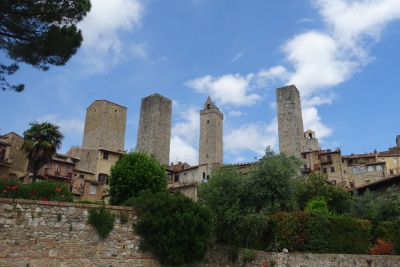
I had one more destination to tick off the list by way of a day trip from Siena first: The impossibly pretty little town of San Gimignano, famous for its medieval towers in the perfectly preserved old city. During a strange phase of one-upmanship in 13th and 14th century the local families kept building higher and higher towers until 72 of them poked into the Tuscan sky and the plague put an end of the madness when it killed half the town's population. Today there's just one street leading from the main square with its bus stop and parking areas through the old city wall into the heart of San Gimignano and while it was predictably full of tourists, it wasn't terribly so and still felt more like a normal living city than Éze on the French Riviera.
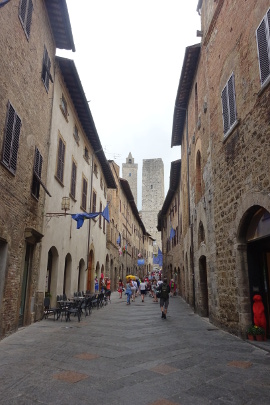 |
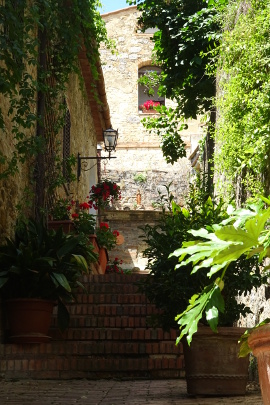 |
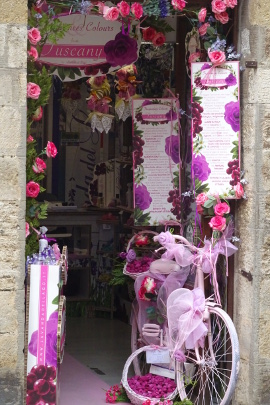 |
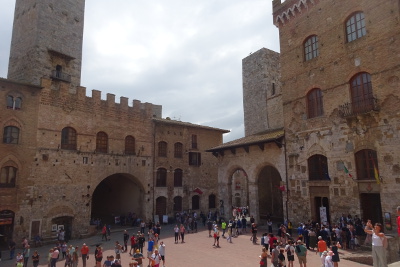
|
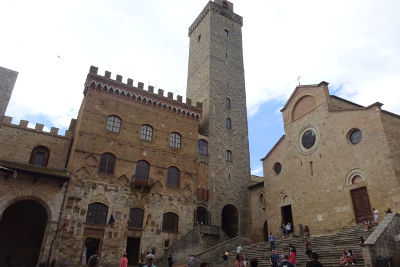 |
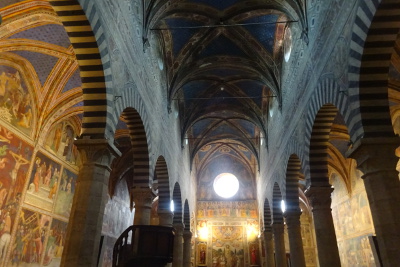
|
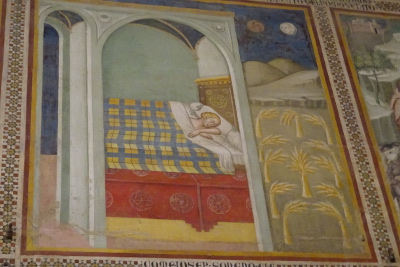 |
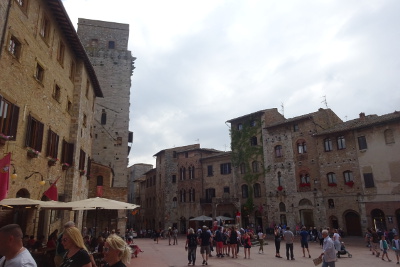
|
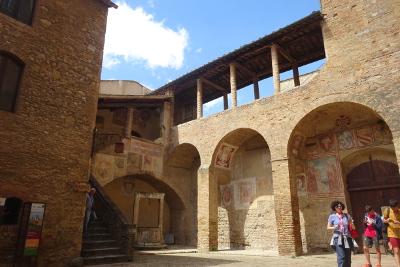 |
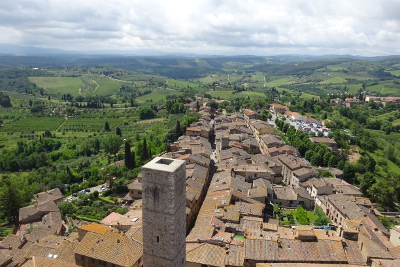
|
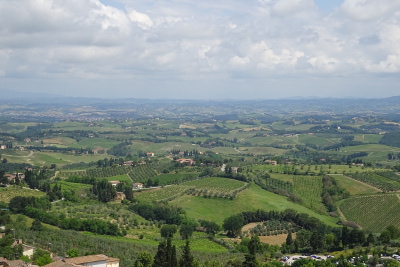 |
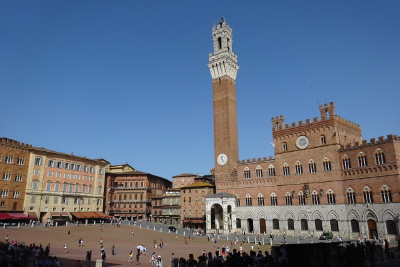 There were also some nice rooms to see in the town hall before I had a light lunch, poked around the touristy shops on the main street and finally left to catch the bus back to Siena. Or so I thought, because the direct bus to Siena I had planned to take did not run on Saturdays, but luckily I twigged that just in time for a bus to nearby Poggibonsi to arrive, from where I could take the train back "home".
After some rest by the hotel pool I walked into Siena, where the famous Campo (along with the whole city) was now basking in Italian sunshine. The shell-shaped square is best-known for the crazy bi-annuel Palio, a medieval horse race (dating back to 1633 in its present form), in which ten of the seventeen Sienese contrade (boroughs) do three laps around the Campo at break-neck speed. I'm sure it's quite a sight to behold, though on this day the Campo along with the Palazzo Pubblico and the Torre del Mangia was peaceful and quiet and the perfect place for a lovely (albeit predictably overpriced) dinner.
There were also some nice rooms to see in the town hall before I had a light lunch, poked around the touristy shops on the main street and finally left to catch the bus back to Siena. Or so I thought, because the direct bus to Siena I had planned to take did not run on Saturdays, but luckily I twigged that just in time for a bus to nearby Poggibonsi to arrive, from where I could take the train back "home".
After some rest by the hotel pool I walked into Siena, where the famous Campo (along with the whole city) was now basking in Italian sunshine. The shell-shaped square is best-known for the crazy bi-annuel Palio, a medieval horse race (dating back to 1633 in its present form), in which ten of the seventeen Sienese contrade (boroughs) do three laps around the Campo at break-neck speed. I'm sure it's quite a sight to behold, though on this day the Campo along with the Palazzo Pubblico and the Torre del Mangia was peaceful and quiet and the perfect place for a lovely (albeit predictably overpriced) dinner.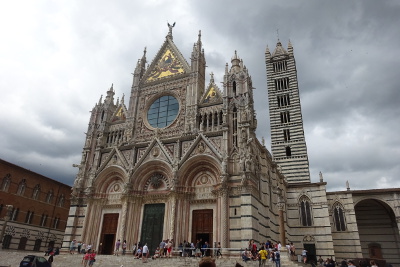 Next day I spent some hours at the hotel pool first before heading into Siena one last time to complete my sightseeing tour. I had actually done the wonderful Duomo on Thursday already before the thunderstorm but feel it fits better into this Siena chapter, so here it is. Like seemingly every other cathedral in Tuscany it's a breathtakingly beautiful work of art both from outside (where it ressembles a pink-white wedding cake) and from inside (where it's stuffed to the rafters with art). Below left are the incredible altar room (left) and the colourful Piccolomini Library, where a cardinal of the same name stowed his library in 16th century and had Pinturrichio paint the colourful frescoes that tell the tale of his uncle who went on to become Pope Pius III.
Next day I spent some hours at the hotel pool first before heading into Siena one last time to complete my sightseeing tour. I had actually done the wonderful Duomo on Thursday already before the thunderstorm but feel it fits better into this Siena chapter, so here it is. Like seemingly every other cathedral in Tuscany it's a breathtakingly beautiful work of art both from outside (where it ressembles a pink-white wedding cake) and from inside (where it's stuffed to the rafters with art). Below left are the incredible altar room (left) and the colourful Piccolomini Library, where a cardinal of the same name stowed his library in 16th century and had Pinturrichio paint the colourful frescoes that tell the tale of his uncle who went on to become Pope Pius III.
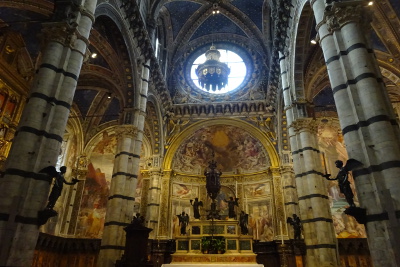
|
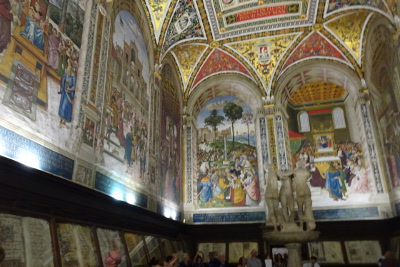 |
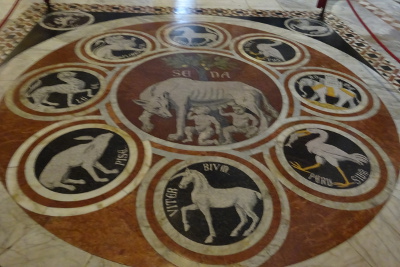
|
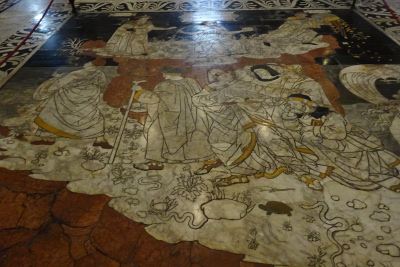 |
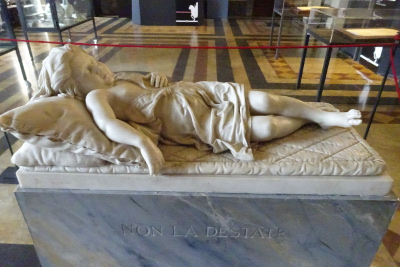 But Siena's cathedral is a place where you should not only look up but also down, because the whole floor is covered in extraordinarly marble mosaics like these ones above.
For the second leg of my Siena sightseeing I had only the Palazzo Pubblico on the Campo left but if I've learned one thing in Tuscany, it's that there's no "only" there where it comes to sightseeing and not surprisingly I felt a lot of sympathy for this sleeping marble girl in one of the public rooms. I could only buy a combination ticket which gave me a time slot "right now!" to climb up the Torre del Mangia, so here I was, climbing another tower of roughly 400 steps to enjoy the view across Siena and down onto the Campo with the Fonte Gaia in the middle:
But Siena's cathedral is a place where you should not only look up but also down, because the whole floor is covered in extraordinarly marble mosaics like these ones above.
For the second leg of my Siena sightseeing I had only the Palazzo Pubblico on the Campo left but if I've learned one thing in Tuscany, it's that there's no "only" there where it comes to sightseeing and not surprisingly I felt a lot of sympathy for this sleeping marble girl in one of the public rooms. I could only buy a combination ticket which gave me a time slot "right now!" to climb up the Torre del Mangia, so here I was, climbing another tower of roughly 400 steps to enjoy the view across Siena and down onto the Campo with the Fonte Gaia in the middle:
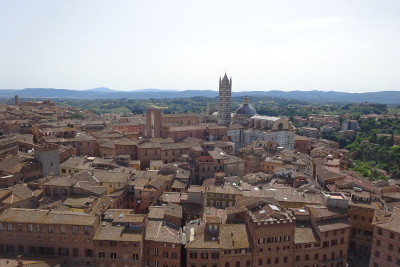
|
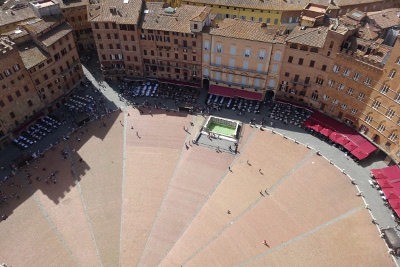 |
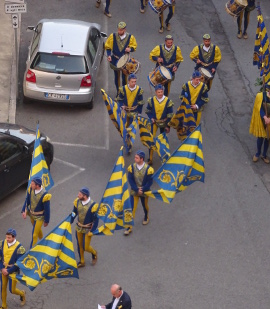
Back in the Palazzo Pubblico my sightseeing suddenly got interrupted by the sound of drums being banged and I realized that from a balcony of the palazzo I had a prime viewing spot of... not sure what actually. But I assume it was one of those Sienense contrade that also do the Palio on parade in their colourful medieval garb with flags, banners and drums and it was quite a sight to see.
The palazzo itself, naturally, was also stuffed to the brim with beautiful frescoes. The most famous being the ones in the "Hall of the Nine" where Siena's rulers congregated under the allegories of good and bad judgement, painted by Ambrogio Lorenzetti in 1338. The other ones show the foundation of modern Italy (a long while later) and the (entirely fictional!) naval battle of Punta San Salvatore, where the Venetians got to whack the Germans led by Barbarossa.

|
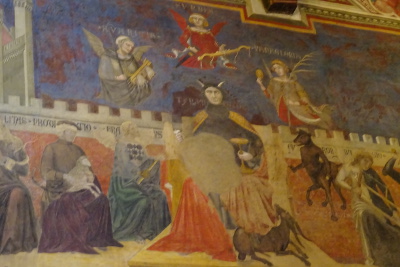 |
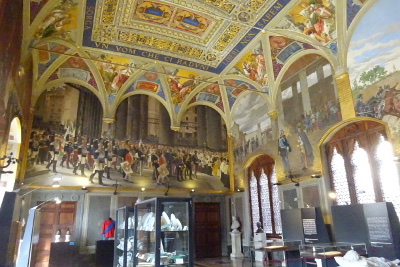
|
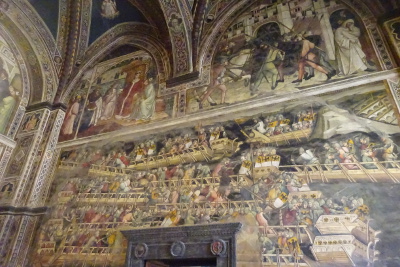 |
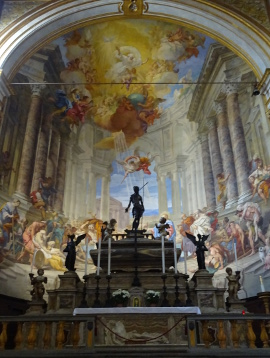
The combination ticket also included entry to Santa Maria della Scala and while I had no idea what that even was, I'd have been damned to let the "free" entry go to waste. And good thing I'm stingy like that: Santa Maria della Scala, just opposite the cathedral, turned out to be one of the first hospitals in Europe. It was founded in 1193, when it catered mostly to pilgrims on the Via Francigena to Rome, and remained operational for many centuries. It was only opened as a museum in 1995 and is still not fully restored and accessible. Here's the former hospital chapel Chiesa della Santissima Annunziata, but the main showcase is the former pilgrim's hall (Pellegrinaio) with its beautiful frescoes showing the medieval work of the hospital:
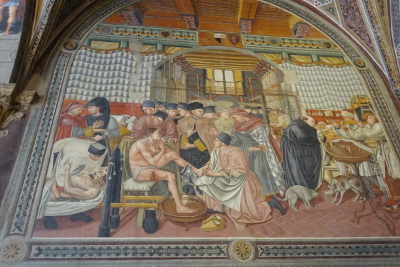
|
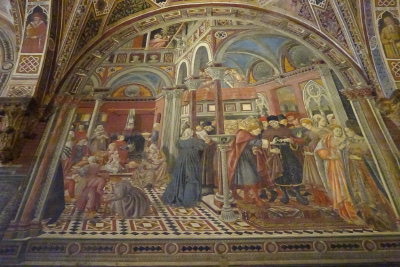 |

And no, the gentlemen in the last fresco on the left haven't met for a communal pedicure, they're part of a bigger fresco depicting the last days of Jesus (during which he washed his disciples' feet). I just really liked that one. There was plenty more to see such as an underground chapel of Saint Caterina, a "covered" street, that was once a normal thoroughfare of Siena until the hospital wound up being build alongside and on top of it, and a small museum with ancient Etruscan and Roman stuff. But while I was certainly glad to have seen the hospital, I was also reaching the end of my tether and only longed to sit down for dinner somewhere.
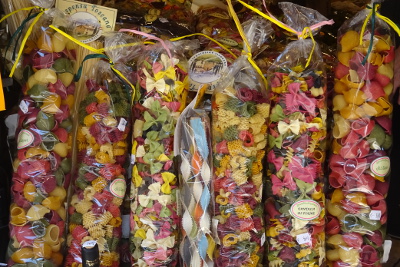
My trip ended quietly with another long morning at the hotel pool before it was time to make the journey back to Pisa Airport, where Eurowings reminded me once more why I've come to detest flying, being a good 90 mins late in the evening, so I didn't get home to bed until 1.30am. But I'm definitely glad I returned to Tuscany to visit the area properly at last and do understand why so many people love this area. However, I think four cities are definitely enough because everything is just so overwhelmingly beautiful and stuffed with so much art, you just can't digest more. And I am pretty sure that I haven't been in that part of Italy for the last time...
Copyright © All Rights Reserved